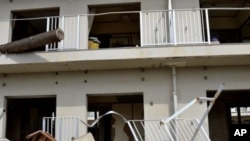Japan collectively paused Sunday afternoon to remember the disaster that struck one year ago and the nearly 20,000 dead or missing.
A magnitude 9.0 quake struck off the country's northeastern coast, unleashing a tsunami at heights not seen in centuries, Coastal areas of many communities were washed out to sea. The disaster also caused the meltdowns of three nuclear reactors. Radiation levels around the Fukushima power plant still are above elevated.
Day of remembrance ceremonies were held in the devastated localities and on a national stage in Tokyo. The event in the capital was attended by Japan's Emperor and Empress. The Emperor's words were broadcast nationwide.
"It is important not to forget the memories of this tragedy and pass them on to our descendants, so that readiness for natural disasters is fostered and we can strive forward in building a safer country," he said.
After the Emperor spoke, a national signal alerted everyone across the country to remain silent for one minute, starting at precisely the time on March 11, 2011 when the ground began shaking.
One Town's Suffering
The Emperor's words were beamed into the public gymnasium in the coastal town of Onnagawa, one of the hardest hit by the tsunami.
After he spoke, survivors in Onnagawa offered flowers for family and friends they last saw one year ago.
Informal remembrances began in the town Saturday evening. Candles were lit for the souls of the dead, while relatives of some of those lost at sea participated in a ceremony on boats in Matsushima Bay, one of the few areas along a 530-kilometer stretch of the Pacific coast that somehow was spared the widespread devastation.
Amid the many tragedies of that day, perhaps none was more poignant than the tsunami striking elementary schools, washing out to sea children and teachers.
That haunts Kazuhiko Abe, a middle school teacher from Onnagawa, who now visits damaged schools in other communities.
He says the young survivors, to his relief, are adjusting relatively well, despite the horror they experienced just one year ago. But for the adults, healing has come slowly, if at all.
“The children are moving on to the next step. Even though I'm a teacher, as an adult, that is what I have learned most from them in the past year,” he said.
A Bell Tolls
At ceremonies in the town of Ishinomaki, a Buddhist priest chanted while survivors and passersby took turns ringing a bell 19,184 times - the official number of dead and missing.
The bell tolling was the idea of Ishinomaki resident Benjamin Loh, a Singapore native who lost his mother-in-law and house to the tsunami.
"It's an event that hopefully helps to show that things are not forgotten, that March 11 is still very much in the memories of everyone, not just in Japan and, I think, in a large part of the world, but especially in this area," he said.
Remnants of Devastation
Throughout the area there are staggering reminders of the tsunami's power. Multi-story buildings still lie on their sides. Other large objects were carried hundreds of meters and have yet to be moved.
Vacant expanses have replaced entire shopping districts and residential neighborhoods.
One of the biggest challenges facing northeastern Japan is what to do with the accumulated mountains of debris and rubble known as "gareki." Authorities estimate there will eventually be 2.2 million metric tons of gareki - everything from smashed vehicles to piles and piles of clothing.
Yet something else to worry about are the frequent aftershocks continuing to rattle the region, forcing jittery survivors to relive that awful day. And many seismologists are warning that the Tokyo metropolitan region, to the south, is overdue for a magnitude 7.0 earthquake - one that could also unleash another killer tsunami, prompting similar misery for a country still grappling with one of its worst-ever disasters.








